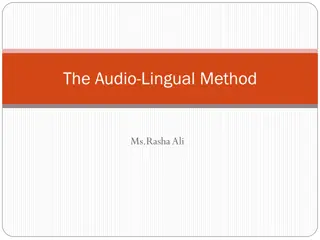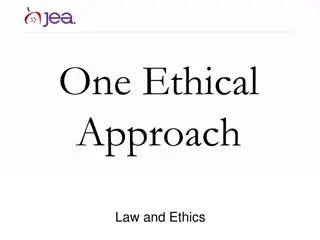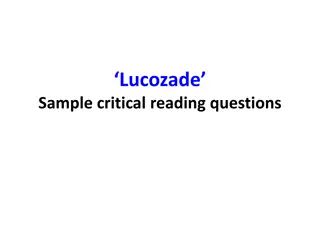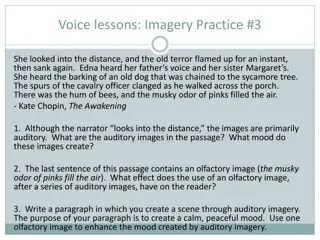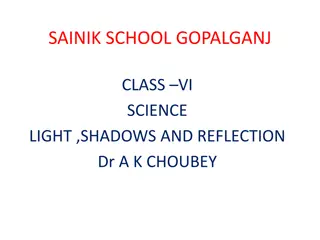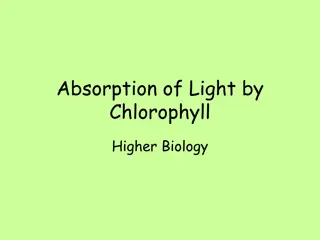The Habit of Light - An Exploration of Language and Imagery by Gillian Clarke
Gillian Clarke's poem "The Habit of Light" beautifully captures the essence of a woman's domestic routine as a sacred ritual. Through vivid language and imagery, Clarke brings to life the character's love for her home and surroundings, celebrating memories of light-filled moments and cherished details. The poem serves as an elegy for the poet's deceased mother, honoring her presence through the depiction of everyday scenes imbued with light and warmth.
Download Presentation

Please find below an Image/Link to download the presentation.
The content on the website is provided AS IS for your information and personal use only. It may not be sold, licensed, or shared on other websites without obtaining consent from the author.If you encounter any issues during the download, it is possible that the publisher has removed the file from their server.
You are allowed to download the files provided on this website for personal or commercial use, subject to the condition that they are used lawfully. All files are the property of their respective owners.
The content on the website is provided AS IS for your information and personal use only. It may not be sold, licensed, or shared on other websites without obtaining consent from the author.
E N D
Presentation Transcript
The Habit of Light LO) To explore how Clarke uses language and imagery to create a vivid character
What words and ideas do you associate with this concept? light
The Habit of Light by Gillian Clarke In the early evening, she liked to switch on the lamps in corners, on low tables, to show off her brass, her polished furniture, her silver and glass. At dawn she d draw all the curtains back for a glimpse of the cloud-lit sea. Her oak floors flickered in an opulence of beeswax and light. In the kitchen, saucepans danced their lids, the kettle purred on the Aga, supper on its breath and the buttery melt of a pie, and beyond the swimming glass of old windows, in the deep perspective of the garden, a blackbird singing, she d come through the bean rows in tottering shoes, her pinny full of strawberries, a lettuce, brining the palest potatoes in a colander, her red hair bright with her habit of colour, her habit of light.
Gillian Clarke This poem is a elegy (serious, meditative poem, usually concerned with the theme of death) where domestic routine is celebrated as a kind of sacrament (ritual/rite = custom). The poem celebrates the poet s dead mother.
Structure 14 lines an informal sonnet, Clarke lovingly details the woman s life in moments of remembered light even down to palest potatoes . Clarke says the poets voice is physical it s not just a metaphor for style, but the sound, the breath. The heard voice and the voice of the poet on the page are connected. Character description is built through sense of place. Relationship with the character and her home (sense of place)
Past tense indicates a memory. Highly descriptive language demonstrates a cherished house. 1st Quatrain Alliteration Works hard to create a pristine house In the early evening, she liked to switch on the lamps in corners, on low tables, to show off her brass, her polished furniture, her silver and glass. At dawn she d draw the curtains back for a glimpse Proud Many adjectives are used throughout the poem to describe the setting/ mother. The poem also makes use of adjectives that describe lightness such as polished . Imagery- objects that cast light or that are shiny.
Adjective that suggests light and grandeur Alliteration helps to create magical atmosphere. 2nd Quatrain Shows possession. Creates mysterious/ beautiful atmosphere of the cloud-lit sea. Her oak floors flickered in an opulence of beeswax and light. In the kitchen, saucepans danced their lids, the kettle purred on the Aga, supper on its breath and the buttery melt House proud - pristine Large steel stove Alliteration reinforces enjoyment of preparing food. The personification used is emotional. Almost as if memory of kitchen is as alive as the memory of her mother. Sentient = emotional
3rd Quatrain Personification Rooted history of a pie, and beyond the swimming glass of old windows, in the deep perspective of the garden, a blackbird singing, she d come through the bean rows in tottering shoes, her pinny full of strawberries, a lettuce, bringing Elegance Details fruit and veg shows uses natural resources to be self sufficient. rows suggests v organised. (apron) self sufficient Could be both literal and a metaphor for the mother singing in the garden.
Positive vibrant images of her mother. Last rhyming couplet Alliteration The palest potatoes in a colander, her red hair bright With her habit of colour, her habit of light. Repetition shows emphasis reflects double meaning: 1) can be used to describe the mother s routine & expectation that all things were kept clean and shining. 2) The word habit describes a religious robe nuns and priests wear. So, could be stating that mother is dressed in colour and in light which may be a religious metaphor for the mother s passing on. Or maybe her religious dedication to keeping the house clean.
Words that help to create a SENSE OF PLACE Words in the poem which suggest light In the early evening, she liked to switch on the lamps in corners, on low tables, to show off her brass, her polished furniture, her silver and glass. At dawn she d draw all the curtains back for a glimpse of the cloud-lit sea. Her oak floors flickered in an opulence of beeswax and light. In the kitchen, saucepans danced their lids, the kettle purred on the Aga, supper on its breath and the buttery melt of a pie, and beyond the swimming glass of old windows, in the deep perspective of the garden, a blackbird singing, she d come through the bean rows in tottering shoes, her pinny full of strawberries, a lettuce, brining the palest potatoes in a colander, her red hair bright with her habit of colour, her habit of light.
In your exercise books: Habit of Light Q1: What is the mother like? List at least 3 things. Q2: How do you know? Explain The character is built through the description of a sense of place. We know about her from her surroundings and how she keeps her house.
Q3. How has the poet created a relationship between the character and her home. Use PEA in your answer.
Q4. How are the references to light in the poem significant? Use PEA in your answer. The reference to light in the poem are significant because .. Light imagery adds to the sense of place and description of character. Light reflects the domestic routine of the character.
How does Clarke use language and imagery to create a vivid character? Introduction Language Structure Conclusion
Plenary To understand the ways in which Clarke has used language and imagery to create a vivid character. To grasp the connection between the character and her home, considering how the description of her home sheds light on the person who lives there. To respond to the sense of warmth and light and to the feeling of pride and love of home created in the poem.




